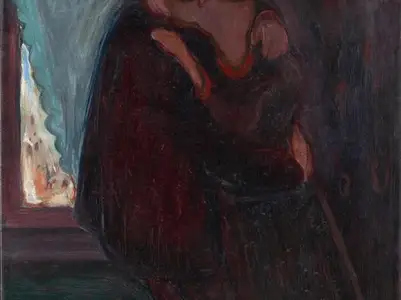Title of Artwork: “Kiss”

Artwork by Edvard Munch
Year Created 1897
Summary of Kiss
Norwegian symbolist artist Edvard Munch finished his oil painting The Kiss on canvas in 1897. The Kiss is an example of a motif with which he had been experimenting since 1888/89, and it is included in his Frieze of Life, which shows the stages of a connection between men and women. It has been on display in the Munch Museum in Oslo since 1903.
All About Kiss
The Kiss is a canvas oil painting that measures 81 x 99 cm (32 x 39 inches). A small amount of light peeks through a partially drawn curtain to illuminate the pair who are otherwise engulfed in shadow.
When they embrace, it’s as if they become one seamless being; their faces become a single, featureless mass. Roberta Smith, an art critic, writes that “long, rather slurpy brush strokes that were more stained than painted” were Munch’s preferred technique.
The picture is reminiscent of, but less complex than, another by Munch from the same time period that explores the same subject matter.
Edvard Munch (1863-1944), a Norwegian symbolist, had to deal with his religious and authoritarian father, as well as illness and death in his family. Throughout his life, Munch suffered from bouts of depression and alcoholism due to heartbreak in love and failing health. Artist was a confirmed bachelor. The results of this were felt in his paintings and his creative output.
Roberta Smith argues that “most of Munch’s figures are not mad but paralysed by oceanic sensations of sadness, jealously, longing, or despair”; these emotions were unsettling to some viewers due to the artist’s sexuality, harsh manner, or suggestions of mental instability. His paintings are frightening, but they are also fascinating because of their emotional honesty and purity.
In both paintings and woodcuts, Munch explored the theme of a kissing pair as early as 1888–1889. In several interpretations of this motif, the couple is set against a backdrop of contrasting interior and exterior environments. The exterior appears energetic and dynamic, while the room’s interior, with the pair caught in their embrace, seems to be stuck in the past.
The abstract shape of the couple, in which their faces seem to have melded into one, represents the couple’s shared sense of belonging and unity. Their bodies eventually joined as well as their faces in subsequent iterations of the motif. The motif was created by Munch as part of a series he titled “The Frieze of Life” and worked on for the better part of three decades.
As part of what Munch dubbed “the war between men and women that is called love,” the cycle represents different points in a couple’s relationship. There are depictions of lust, courtship, self-awareness, and heartbreak.
The sombre tone of The Kiss, as interpreted by the Museum of Modern Art, is a reflection of Munch’s conflicted feelings about romantic love. Reinhold Heller, an art historian, calls it “nearly impossible” to distinguish between the two figures in the artwork from 1897, especially in the area where their faces merge.
As he sees it, the couple’s picture represents both their oneness and the imminent “loss of individuality, a loss of one’s own existence and identity,” which is a hint at death.
Information Citations;
En.wikipedia.org, https://en.wikipedia.org/.

























